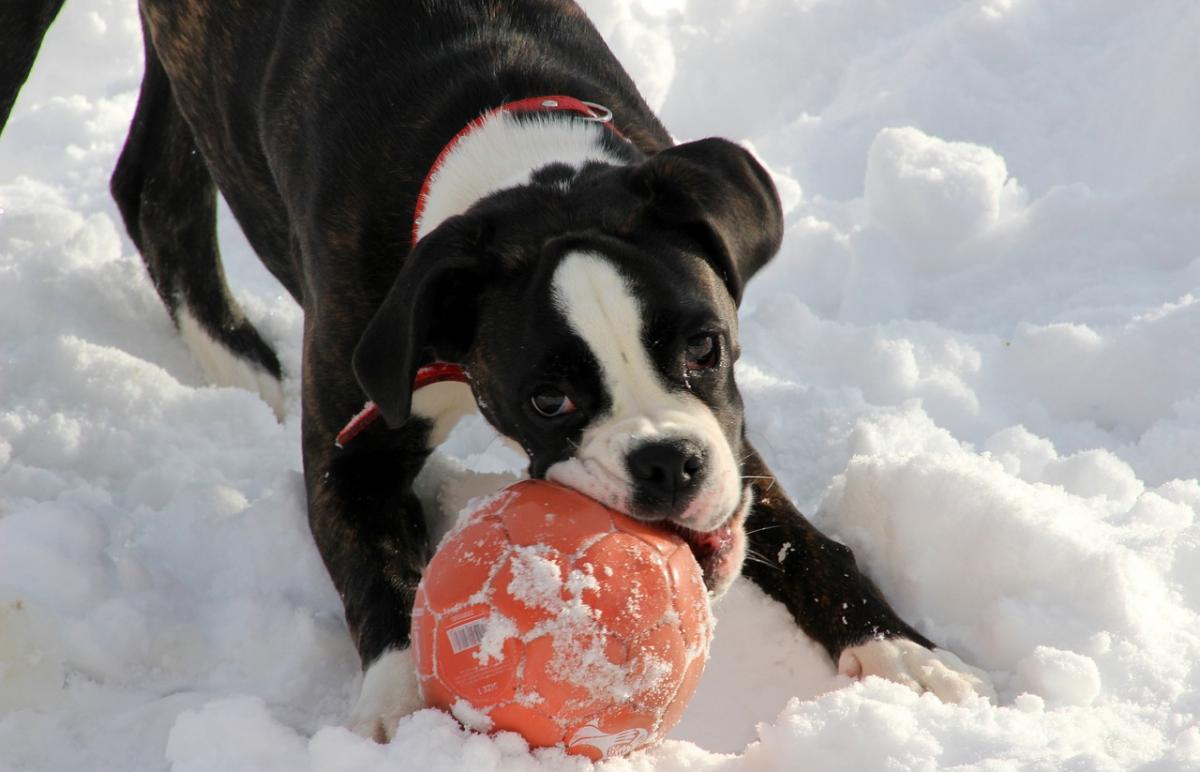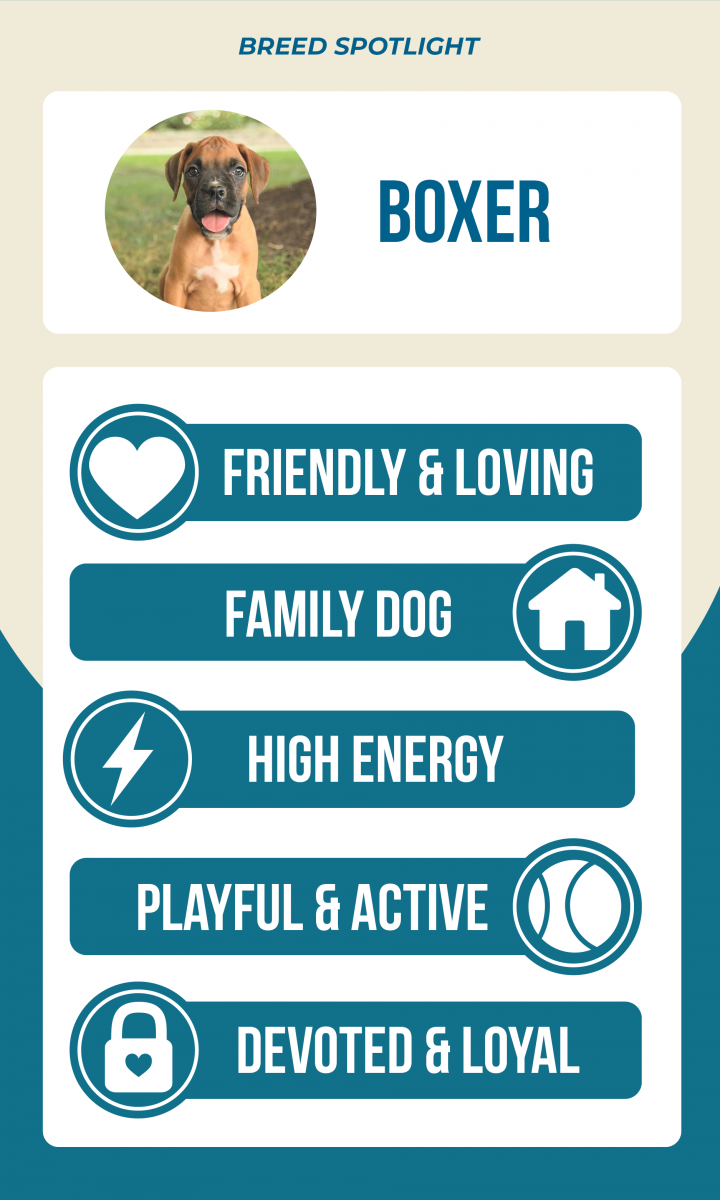Upbeat, fun-loving, and affectionate, it’s no surprise that the Boxer ranks among the top dog breeds in America. If you’re thinking of adding one of these pups to your family, read on for a complete overview of all things Boxers.
History of the Boxer Dog Breed
While the Boxer’s ancestors can be traced back to ancient times, the Boxer dog breed that we know today descends from two dogs of the (now extinct) Bullenbeisser breed from Germany: the Danziger Bullenbeisser and the Brabanter Bullenbeisser. Both of these dogs were used by hunters and noblemen for chasing large game, and also as guard dogs.
During the mid-1800s, German hunters began crossing their Bullenbeissers with Mastiff-type dogs and Bulldogs in an effort to combine the best traits of all three breeds. The resulting breed was a tough, strong dog with a powerful jaw. This dog was the foundation for a completely new breed: the Boxer, which became fully established by 1900.
Despite receiving recognition from the American Kennel Club (AKC) in 1904, Boxers were not well-known in the United States until soldiers started bringing them back from Germany at the end of World War II. Once they arrived in America, however, Boxers gained much more popularity and are now among the most popular dog breeds in the United States.
Boxer Characteristics
Appearance
A member of the Working Group, the Boxer is a medium to large-sized dog, standing around 21 to 25 inches tall at the withers. Depending on sex, a healthy weight for a Boxer ranges from 55 to 70 pounds.
A Boxer’s coat is short, smooth, and shiny. In terms of color, their coats can either be fawn or brindle. Fawn ranges from light tan to mahogany, while brindle is made up of black, tiger-like stripes on a fawn background. Some Boxers will also have white markings on their stomach or feet.
Temperament
Boxers are active, playful family dogs that have earned a reputation as both protective guardians and silly companions. They are very affectionate and difficult to provoke to anger, making them great with children. Boxers tend to be a bit distrustful of strangers at first, but they typically respond well to friendly people. Regardless, early socialization for the Boxer is a must.
Health
Generally speaking, the Boxer is a healthy breed. However, like all dogs, they are at risk for certain health conditions. One of these is Boxer Cardiomyopathy, or Boxer Arrhythmic Cardiomyopathy, an inherited condition in which a dog’s heart beats erratically as a result of an electrical conduction disorder.
Boxers are also prone to hip and elbow dysplasia, hypothyroidism, and aortic and subaortic stenosis (AS/SAS). Reputable breeders will screen their dogs for these health conditions before breeding, so be sure to keep that in mind when finding your Boxer dog puppy. Steer clear of breeders who do not provide adequate documentation from a veterinarian.
It’s also worth noting that, due to some of its physical characteristics, the Boxer does not have a high tolerance for extreme heat or cold. That said, you should not leave a Boxer outside for prolonged periods of time.
Caring for a Boxer
A Boxer’s Ideal Home
Known for their love and loyalty, Boxers make wonderful family dogs. They are gentle and patient with children, and they can usually get along well with other pets. It’s important to note that Boxers are high-energy dogs, so make sure that you have the time and energy to give them the activity they need before bringing one into your home.
When they’re not playing or romping around, a Boxer can be quite the lapdog. In fact, many Boxers will try to be as close in proximity to their humans as possible. As long as they receive plenty of exercise and playtime, Boxers are great family companions that will do well in a variety of different households. With adequate activity, they can even adapt to apartment living.
Training Best Practices
Like with all dogs, it’s important to start training your Boxer as soon as you bring them home. These dogs respond best to firm, but fun training. An intelligent breed, Boxers can become bored with repetition, so be sure to keep them on their toes with interesting and engaging training sessions. A Boxer will also benefit from positive reinforcement in the form of  treats and praise.
treats and praise.
Potty training your Boxer should begin right away. Establishing a consistent schedule is key when it comes to housetraining. Taking your puppy outside on a regular schedule will help to establish a routine and prevent accidents in the house. With patience and consistency, Boxers can typically be potty trained in a matter of months.
Exercise
It’s no secret that Boxers are among the more energetic dog breeds. That said, they need ample exercise every day to keep them from developing boredom-based behaviors like digging holes or chewing through furniture.
Additionally, make sure to always keep your Boxer on a leash or in a fenced-in area whenever they are outside. Due to their hunting and chasing instincts, these dogs should never be allowed to run loose.
Grooming and Hygiene
Due to their short and smooth coat, the Boxer doesn’t require too much grooming. In most cases, weekly brushing with a firm bristle brush or rubber grooming mitt is all it takes to reduce shedding and keep the dog’s coat looking shiny and healthy. Boxers are generally clean dogs, so frequent baths aren’t necessary unless they get dirty.
Other areas of hygiene include teeth brushing and nail care. It’s recommended that you brush your Boxer’s teeth several times a week to prevent bacteria buildup and remove tartar. In terms of nail care, you should trim your Boxer’s nails at least once a month, unless your dog wears them down naturally. A good rule of thumb is that if you can hear your dog’s nails clicking on the floor, they’re too long.
If you’ve determined that it’s time to add a Boxer dog puppy to your family, look no further than Lancaster Puppies! Browse Boxer puppies for sale from reputable breeders and find your new furry friend today!


